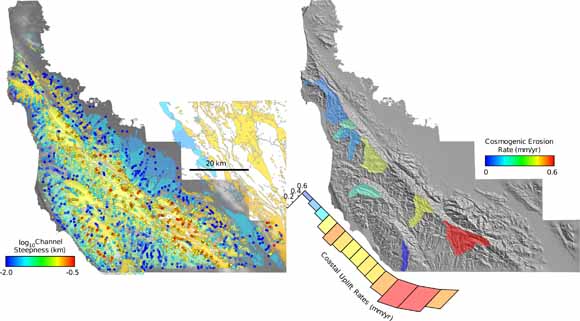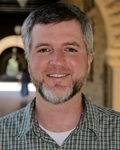
Location: Stanford University
This will be the 409th meeting since 1954

Metrics of landscape steepness have been used as a reconnaissance tool to identify locations of rapid modern tectonic rock uplift rates. Our previous work along the San Andreas Fault in the Carrizo Plain, California, indicates that various landscape metrics correlate systematically with tectonic rates along a ~4.5-km-long landform that is underlain by a poorly consolidated, relatively mechanically homogeneous substrate. To determine if such relationships are applicable to larger mountain ranges that constitute complex composite geologic features, we have focussed our attention on the Santa Cruz Mountains, which was the location of the 1989 Loma Prieta Earthquake. Several lines of geologic and geomorphic evidence indicate that the topography of this range results from deformation of material as it is moved into and through a restraining bend that creates a zone of active uplift. To constrain the kinematics of the range, we used low-temperature thermochronology (paired apatite fission track and (U-Th)/He analyses) to infer the exhumation history of the Sierra Azul Block, and cosmogenically-derived estimates of averaged erosion rates in basins draining the La Honda Block, between the San Andreas and San Gregorio Faults. The low-temperature thermochronologic measurements in the Sierra Azul image a pulse of exhumation around ~4-6 Ma, which apparently resulted from rapid deformation in this range. Since that time, exhumation across the range appears to have been relatively steady and slow. In contrast, cosmogenically-derived erosion rates within the La Honda Block decrease systematically with distance from the Santa Cruz Mountains restraining bend. These rates quantitatively mimic rock uplift rates inferred from marine terrace uplift rates along the Pacific Coast, indicating that such measurements might be used to identify the location of contractional structures that would be difficult to image by other means. When comparing topographic metrics such as hillslope and channel steepness to the erosion/uplift history inferred from geochronologic measurements, we found that unlike erosion rates, the variation in topographic steepness across the range is subtle. However, we did find an excellent correspondence between landscape steepness and the exposure of particular rock types within catchments of this range-- often the diversity of rock types leaves an imprint on landscape steepness that is comparable to or larger than the signal produced by tectonic uplift. We conclude that in simple landscapes constructed in unconsolidated, relatively homogeneous substrates such as those we have studied in the Carrizo Plain, various metrics inferred from topographic data may provide faithful proxies for vertical tectonic deformation rates. However, the exposure of different lithologies in complex composite geologic features such as an entire mountain range may leave an imprint on the topography that is at least as important as tectonic uplift.

Jonathan Stock
George Earl Hilley is an Assistant Professor, Geological & Environmental Sciences at the Stanford University School of Earth Sciences. His interests include active tectonics, quantitative structural geology and geomorphology; Geographic Information Systems; unsaturated zone gas transport; near-surface hydrologic response and landscape development; active deformation and mountain belt growth in central Asia, central Andes, and along the San Andreas Fault; and integrated investigation of earthquake hazards. George received a B.S. in Geological and Environmental Sciences at Stanford University in 1996 and a Ph.D. in Geology from Arizona State University in 2001. He did postdoctoral research at Cal and Universitaet Potsdam.
Reservations: The preferred way to make reservations is simply to email John Spritzer at jspritzer@usgs.gov by Nov. 6, tell him you will attend, commit to pay, and bring your payment to the meeting. John always emails a confirmation; if you don’t get one, assume email crashed yet again and email him a second time. A check made to “PGS” is preferred, payable at the meeting.
If you want to pay in advance:
Everyone (including Stanford folks now) Please make dinner reservations by Nov. 6. Contact John Spritzer, at U.S. Geological Survey, 345 Middlefield Road, MS-973 Menlo Park, CA 94025, Tel.: (650) 329-4833. Send check made out to “PGS” to John.
Dinner is $35.00. Includes wine (5:30 to 6:15 PM.) and dinner (6:15-7:30 PM.).
For students from all universities and colleges, the dinner, including the social 3/4-hour, is $8.00 and is partially subsidized thanks to the School of Earth Sciences, Stanford University (Note, no-show reservations owe the full price).
Doris, whose wonderful crew prepares our meals, asked that we let you know that people who are late RSVPing and people who show up without a reservation will be welcome but that they will be eating on paper plates with plastic utensils (food supply permitting).
Dues for Academic Year 2009-2010 ($10.00) should be sent to John Spritzer, U.S. Geological Survey, 345 Middlefield Road, MS-973 _Menlo Park, CA 94025. John’s phone: (650) 329-4833.
Officers: Vicki Langenheim, President; Jon Hagstrum, Vice President; Mike Diggles, Secretary; John Spritzer, Treasurer; Elizabeth Miller, PGS Stanford University Coordinator

Date created: October 26, 2009
Last modified: October 26, 2009
Created by: Mike Diggles, Webmaster-Secretary, PGS.